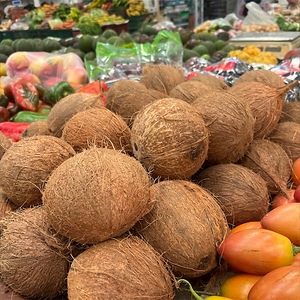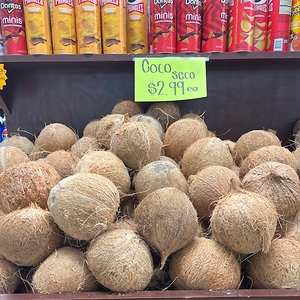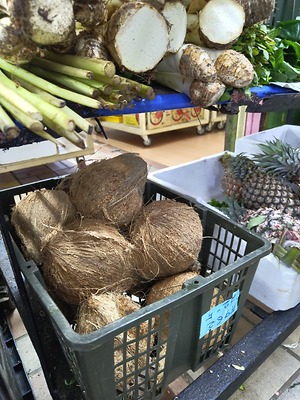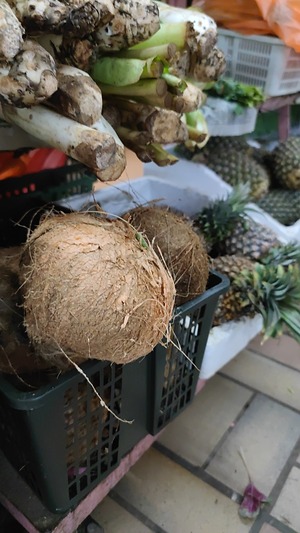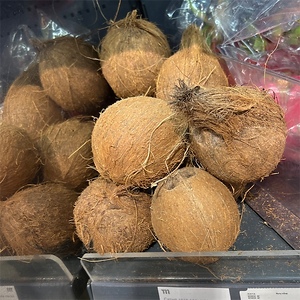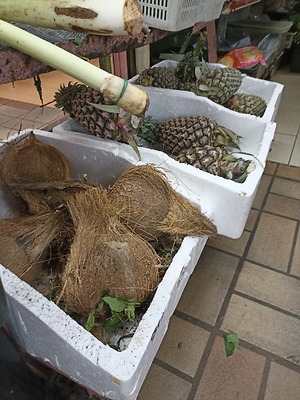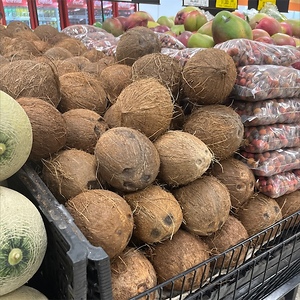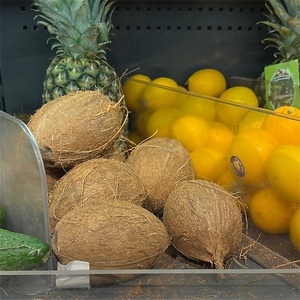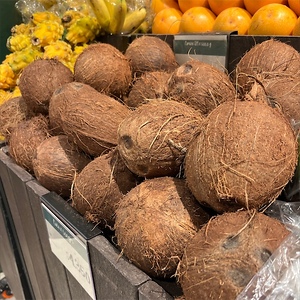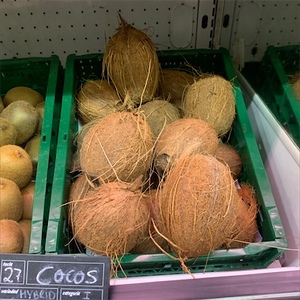


Husked Coconuts
Estimated Inventory, 20 ct : 2.75
This item was last sold on : 07/16/25
Description/Taste
Husked coconuts are fruits that have had their rough, brown fuzzy husks removed. Once removed, a hard, brown shell enclosing coconut water and white, edible flesh called the meat of the coconut remain. There are multiple varieties of Husked coconuts, the majority of which range from about 30 to 36 centimeters in diameter. They tend to be heavy for their size, weighing about 500 to 650 grams, and contain juice that makes an audible sloshing sound when shaken. The outer brown shell has a hard, wood-like texture that's rough and fibrous. This shell is dark brown with small, textured pores covering its round exterior. When Husked coconuts are sliced open, the white coconut meat inside is exposed. This meat initially has a soft, jelly-like texture that becomes firm, crisp, and crunchy as the fruit matures. It feels creamy, smooth, and oily, particularly when removed and used in food. Within the meat is partially transparent, white liquid coconut water that has a thin, watery consistency. While the shell of the Husked coconut is not edible, the aromatic meat has a nutty, candy-like sweetness, and the water has a similarly sweet flavor with floral notes.
Seasons/Availability
Husked coconuts are available year-round.
Current Facts
Husked coconuts are botanically classified as Cocos nucifera and belong to the Arecaceae family. This family is made up of about 2,600 species of palm trees known for their large, evergreen fronds that grow out of the top of their trees. In some of these palms, coconuts develop where the trees' fronds emerge. Coconuts are classified as both a fruit and a drupe, similar to peaches, pears, almonds, and walnuts. They come in many varieties, including Macapuno, Fiji Dwarf, King Coconut, and Green Dwarf coconuts. There are three different maturation points of this fruit: the young coconut, the white coconut, and the most mature of the three, the brown Husked coconut. Unhusked coconuts are often used for their ornamental value, as the outer shell can be crafted into decorations and products like mats, brushes, and ropes. In contrast, Husked coconuts are primarily valued for their culinary uses.
Nutritional Value
Husked coconuts are a good source of copper, a mineral that helps form red blood cells, maintain healthy bones and nerves, and support immune health. The selenium found in coconuts helps protect cells from damage and supports thyroid function. The iron in this fruit is essential for energy production and oxygen transport, helping to prevent anemia. Coconuts also contain some phosphorus, which is important for strong bones and teeth. They provide potassium to regulate blood pressure and fluid balance, magnesium to encourage muscle function and heart health, and zinc to support immune function, wound healing, and DNA synthesis.
Applications
Husked coconuts are primarily valued for their water and meat. To consume them, the brown shell must be carefully peeled away with a small knife. Grated coconut meat can be used to make coconut milk by wrapping it in cheesecloth and placing it over a bowl. Pour half a cup of warm water over the grated coconut and allow the liquid to drain into the bowl. This process can be repeated multiple times, producing coconut milk of varying thicknesses. Both the milk and meat can be incorporated into fruit salads, puddings, cakes, cookies, custards, pies, and macarons. They can also be used for pasta sauces, curries, soups, rice, smoothies, lattes, and breading for frying fish and chicken. The flavors of coconut pair well with chocolate, lentils, shrimp, peanuts, pecans, tapioca, ginger, lemongrass, basil, lime, oranges, apricots, mangoes, pineapple, bananas, strawberries, raspberries, and currants. Husked coconuts will keep at room temperature for two weeks. Grated coconut will keep for two weeks when refrigerated in a glass jar. Place a whole hot chile in with the coconut to keep it from going bad.
Ethnic/Cultural Info
In Hinduism, coconuts symbolize the trinity of Brahma, Vishnu, and Mahesh, representing the creator, the protector, and the destroyer. In Hindu mythology, the Lord Vishnu descended on Earth bringing the Goddess Lakshmi, a Kamdhenu cow, and a coconut tree. The act of breaking coconuts is a sacred practice as the fruit symbolizes different elements of human nature and each person's spiritual journey. The outer shell represents the ego, and breaking it is symbolic of letting go of one’s pride. Once broken, the soft, pulpy coconut inside represents a human heart, allowing people to show humility and compassion.
Geography/History
There is some disagreement among botanists regarding the origin of coconuts. Many believe they originated in the East Indies and Melanesia, while others suggest tropical America. The first recorded mention of coconuts dates back to 545 CE, when an Egyptian monk referred to them as the great nut of India after visiting Western India and Ceylon. Coconuts flourish in tropical climates, particularly along seashores. While their species may be found in the wild, Husked coconuts must be manually or mechanically processed to remove their outer husk and are only prepared in commercial and private settings. The world's major coconut producers include the Philippines, India, Indonesia, Malaysia, Sri Lanka, Papua New Guinea, Honduras, the Dominican Republic, and Puerto Rico. Coconuts remain a popular fruit that can be found in most grocery stores throughout the world.
Featured Restaurants
Restaurants currently purchasing this product as an ingredient for their menu.
| Dot Cafe | San Diego CA | 914-263-1424 |
| Finca North Park | San Diego CA | 619-581-3003 |
| Margaritaville Hotel SD (Kitchen) | San Diego CA | 619-819-9500 |
| Lauberge Del Mar | Del Mar CA | 858-259-1515 |
| The Santaluz Club Inc - Banquet | San Diego CA | 858-759-3150 |
Recipe Ideas
Recipes that include Husked Coconuts. One
| Su-Mei Yu Thai Living |
|
Coconut Milk & Cream |



